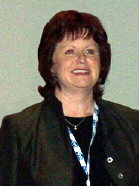Wal-Mart brought out its big guns to convince suppliers that it is serious about using the Electronic Product Code (EPC) to track pallets and cases. The message was delivered by Vice Chairman Tom Coughlin, Wal-Mart Stores President and CEO Mike Duke, CIO Linda Dillman and others at a gathering of Wal-Mart’s top 100 suppliers outside of Bentonville, Ark., on Nov. 4 and Nov. 5.
Wal-Mart called the meeting to inform its top 100 suppliers—representatives from about 120 top companies came—about what exactly would be required of them come January 2005, when Wal-Mart wants to begin tracking items using EPCs. Senior executives met with representatives from the suppliers’ companies on Nov. 4 for most of the day. Dillman addressed RFID vendors in the evening. The following day, suppliers were able to visit booths set up by the RFID vendors.
The retailer plans to use a 96-bit EPC with a Global Trade Identification Number, an international standard. It is only interested in tags that operate in the UHF spectrum, which was defined as 868 MHz to 956 MHz. Class 1, Class 0 and Class 0 Plus (a read-write version of Class 0) tags are acceptable, but Dillman said Wal-Mart would like to see suppliers to move to Class 1 version 2 as soon as the specification is ready. (For more on this, see Wal-Mart Opts for EPC Class 1, V2.)
Dillman said Wal-Mart is already tracking pallets and cases from two suppliers coming into one distribution center. She said the retailer wants to quickly expand that to 12 suppliers. Beyond that, the company plans to roll out the technology regionally across the United States. By the end of 2005, it expects to be tracking all pallets and cases of all products from its top 100 U.S. suppliers. By the end of the following year, it hopes to be tracking all pallets and cases from all of its U.S. suppliers. Wal-Mart will then begin rolling the technology out internationally.
Wal-Mart wants to be able to read 100 percent of the pallet tags coming through its dock doors. It doesn’t expect to be able to read 100 percent of cases coming through a dock door, but it will require that for hand scanning. And it expects all tags to be read without slowing down the existing process.
“Wal-Mart is saying to CPG companies and RFID vendors, here’s the bar; see if you can meet and exceed this,” says Jonathan Loretto, global lead for RFID at Cap Gemini Ernst & Young. “It’s achievable. Whether it’s achievable in the next 12 months, only time will tell.”
Nearly 95 percent of attendees at RFID Journal University in New York said they would recommend the program to a colleague. There’s still time to sign up for the final RFID Journal University in Chicago (Nov. 17). Register now by visiting RFID Journal University, or call 510-832-1501.


